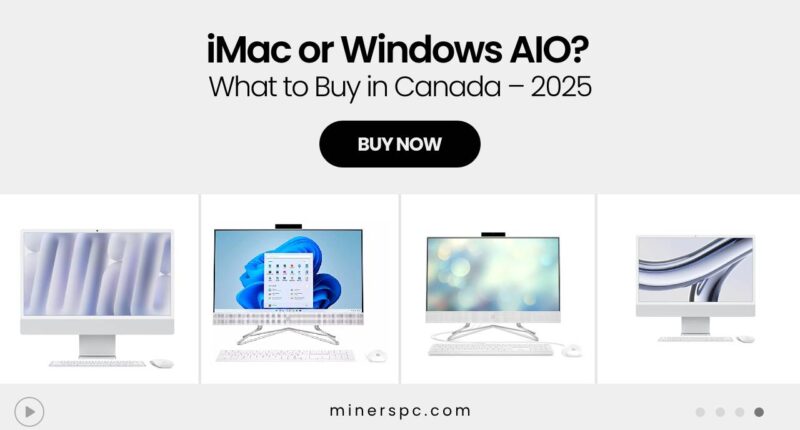In 2025, the All-in-One (AIO) PC landscape in Canada is more competitive than ever — and the age-old question persists: Should you go with a sleek Apple iMac or a versatile Windows-powered AIO desktop?
Whether you’re upgrading your home office, setting up a digital hub for your family, or finally replacing that clunky tower setup, both platforms offer solid choices. But which one truly fits your needs, your lifestyle, and yes — your desk?
We tested and compared this year’s standout iMac and Windows AIO models, and the verdict? It depends on what kind of experience you’re looking for. Let’s break it down so you can make a confident, informed decision.
Design & Aesthetics: Apple Still Owns the Crown
If you want your workspace to look as polished as a design studio in downtown Toronto, the iMac is hard to beat. With its razor-thin profile, vibrant colour options, and all-metal finish, the Apple 2024 iMac with the new M4 chip feels more like a piece of art than a computer. Even the cables are designed with intention — minimal, clean, and tucked away.
That said, Windows AIOs have stepped up significantly. Models like the Acer Aspire C24-1700-UA91 and Dell 2023 AIO-Inspiron-i5420 now feature slim bezels, compact builds, and stylish stands that blend well into both professional and casual environments.
➡ Verdict: iMac wins for design purists, but modern Windows AIOs aren’t far behind.
Performance: M-Series vs. Multi-Choice Processing Power
Apple’s silicon chips — the M3 and now the M4 — have revolutionized the Mac ecosystem. They’re blazing fast, especially for creative work. The Apple 2024 iMac with M4 chip and 10-core GPU handles 4K video editing, music production, and multitasking like a dream, with incredible energy efficiency to boot.
However, Windows gives you options. Want an Intel Core i7 for multitasking? A Ryzen chip for gaming and streaming? You’ve got flexibility. The Dell Inspiron i5420 and HP AIO-24-DF, for example, offer serious horsepower for students, remote workers, and even light creative use — often at a lower cost.
➡ Verdict: Apple delivers streamlined, high-end performance; Windows offers flexibility and broader compatibility.
Software Ecosystem: What Do You Use Every Day?
This one’s simple: if you’re already deep in the Apple ecosystem — iPhone, iPad, iCloud, AirDrop — then the Apple iMac will make your life easier. It syncs seamlessly across devices, and macOS Sonoma (and beyond) continues to focus on privacy, speed, and intuitive UX.
But for users who rely on Microsoft Office, gaming platforms, or custom apps for work, Windows AIOs like the HP AIO 22-dd000 offer better software compatibility. Plus, Windows 11 continues to improve its user interface, touch capabilities, and performance for hybrid workflows.
➡ Verdict: Stick with what you’re already using. Apple if you’re all-in with iOS/macOS; Windows if you want universal compatibility.
Touchscreens & Flexibility: Windows Takes the Lead
If you’re looking for a touchscreen interface, the iMac still lags behind — even in 2025. Apple prefers to keep macOS separate from its touch-based iPads, despite user demand.
Windows, on the other hand, embraces touch. The HP AIO-24-DF and Dell Inspiron i5420 feature responsive touchscreen displays that work great for sketching, editing, or intuitive browsing. For families or creatives who enjoy interactive work, Windows AIOs offer more hands-on control.
➡ Verdict: Touch users and creatives may prefer Windows-based AIOs.
Setup, Maintenance, and Ease of Use
One area where Apple shines — especially for seniors or first-time users — is setup. Unbox the iMac, plug it in, and you’re ready to go. There’s virtually no bloatware, and the interface is as intuitive as it gets.
Windows AIOs like the Acer Aspire C24-963-UA91 have made great strides, offering guided setup and better security defaults. But there can still be extra steps, especially for removing pre-installed apps or syncing multiple accounts.
➡ Verdict: iMac is simpler to start and easier to maintain; Windows requires a little more hands-on configuration.
Storage, Upgrades, and Customization
This is where Apple shows its limitations. With newer iMac models, what you buy is essentially what you’re stuck with. RAM and storage aren’t user-upgradable, so choose wisely at checkout.
Windows AIOs often offer more customization. Models like the HP AIO 22-dd000 or Acer Aspire C24-963-UA91 sometimes allow for RAM upgrades or expanded storage down the line — a plus for users who plan to grow into their system.
➡ Verdict: Windows wins for long-term flexibility and upgradability.
Real-Life Use Case: What Works Best for Different Canadians?
- Creative Professionals (Graphic Designers, Editors)
The Apple 2024 iMac with M4 chip is tailor-made for creative workflows. The Retina display is stunning, the colour accuracy is industry-leading, and the M4 chip handles intensive apps without lag. - Home Office & Remote Work
The Dell Inspiron i5420 and HP AIO-24-DF are reliable, fast, and ideal for multitasking. You’ll get Microsoft Teams, Zoom, Chrome, and email running smoothly with room to spare. - Families & Casual Use
The HP AIO 22-dd000 is perfect for schoolwork, video calls, and Netflix marathons — and with touch features, it’s kid-friendly too. - Seniors & New Users
The iMac’s plug-and-play design, minimal setup, and clean interface make it the best option for users who want simplicity and reliability out of the box.
Final Thoughts: So, iMac or Windows AIO?
Both iMac and Windows AIOs have evolved into excellent options in 2025, especially for Canadian households and professionals. The right choice depends on your needs and preferences:
- Go iMac if you want a gorgeous, intuitive machine with seamless Apple ecosystem integration.
- Go Windows AIO if you want more variety, touchscreens, upgradability, and app compatibility.
Ultimately, either route will declutter your workspace and boost your productivity — it just comes down to how you prefer to work, play, and create.
Looking for the perfect pick? Explore the top recommendations below while they’re still available – these won’t stay in stock for long.














![Best Prebuilt PCs in Canada for Work, School & Gaming [2025 Guide]](https://www.minerspc.com/wp-content/uploads/2025/07/best-prebuilt-pcs-in-canada-for-work-school-gaming-2025-guide-260x140.jpg)


